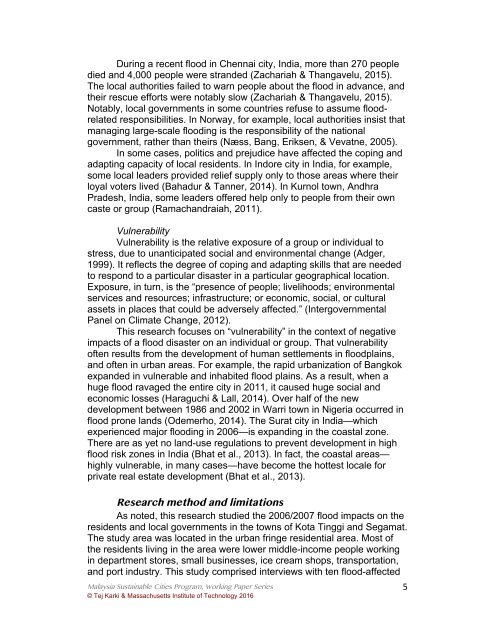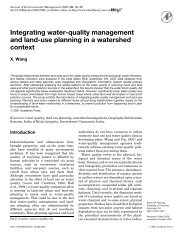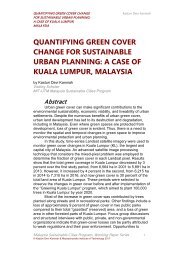You also want an ePaper? Increase the reach of your titles
YUMPU automatically turns print PDFs into web optimized ePapers that Google loves.
During a recent flood in Chennai city, India, more than 270 people<br />
died and 4,000 people were stranded (Zachariah & Thangavelu, 2015).<br />
The local authorities failed to warn people about the flood in advance, and<br />
their rescue efforts were notably slow (Zachariah & Thangavelu, 2015).<br />
Notably, local governments in some countries refuse to assume floodrelated<br />
responsibilities. In Norway, for example, local authorities insist that<br />
managing large-scale flooding is the responsibility of the national<br />
government, rather than theirs (Næss, Bang, Eriksen, & Vevatne, 2005).<br />
In some cases, politics and prejudice have affected the coping and<br />
adapting capacity of local residents. In Indore city in India, for example,<br />
some local leaders provided relief supply only to those areas where their<br />
loyal voters lived (Bahadur & Tanner, 2014). In Kurnol town, Andhra<br />
Pradesh, India, some leaders offered help only to people from their own<br />
caste or group (Ramachandraiah, 2011).<br />
Vulnerability<br />
Vulnerability is the relative exposure of a group or individual to<br />
stress, due to unanticipated social and environmental change (Adger,<br />
1999). It reflects the degree of coping and adapting skills that are needed<br />
to respond to a particular disaster in a particular geographical location.<br />
Exposure, in turn, is the “presence of people; livelihoods; environmental<br />
services and resources; infrastructure; or economic, social, or cultural<br />
assets in places that could be adversely affected.” (Intergovernmental<br />
Panel on Climate Change, 2012).<br />
This research focuses on “vulnerability” in the context of negative<br />
impacts of a flood disaster on an individual or group. That vulnerability<br />
often results from the development of human settlements in floodplains,<br />
and often in urban areas. For example, the rapid urbanization of Bangkok<br />
expanded in vulnerable and inhabited flood plains. As a result, when a<br />
huge flood ravaged the entire city in 2011, it caused huge social and<br />
economic losses (Haraguchi & Lall, 2014). Over half of the new<br />
development between 1986 and 2002 in Warri town in Nigeria occurred in<br />
flood prone lands (Odemerho, 2014). The Surat city in India—which<br />
experienced major flooding in 2006—is expanding in the coastal zone.<br />
There are as yet no land-use regulations to prevent development in high<br />
flood risk zones in India (Bhat et al., 2013). In fact, the coastal areas—<br />
highly vulnerable, in many cases—have become the hottest locale for<br />
private real estate development (Bhat et al., 2013).<br />
Research method and limitations<br />
As noted, this research studied the 2006/2007 flood impacts on the<br />
residents and local governments in the towns of Kota Tinggi and Segamat.<br />
The study area was located in the urban fringe residential area. Most of<br />
the residents living in the area were lower middle-income people working<br />
in department stores, small businesses, ice cream shops, transportation,<br />
and port industry. This study comprised interviews with ten flood-affected<br />
Malaysia Sustainable Cities Program, Working Paper Series<br />
© Tej <strong>Karki</strong> & Massachusetts Institute of Technology 2016<br />
5






